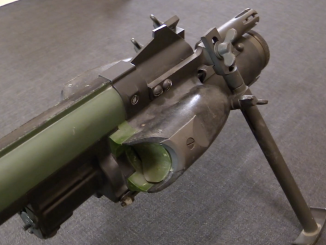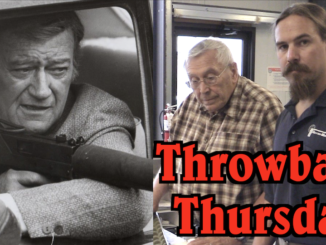The Colt 1847 Walker revolver was a massive 4 1/2 pound handgun made for Samuel Walker of the US Mounted Rifles (he also served with the Texas Rangers) as a way to equip mounted troops with greater firepower than single-shot carbines. The Walker was the first true martial handgun made by Colt, and despite its problems (nearly a third of the guns procured by the military would be returned to Colt for repairs, and more than a few literally blew up) it would save Colt from bankruptcy after the commercial failure of his Paterson revolver of 1836.
Only 1100 of these guns were mad, 1000 for the military and a further 100 for commercial sale. The military ones were issued to 5 companied of Mounted Rifles, and can be identified by their factory unit marks for Companies A through E (this particular gun is a Company A one). Roughly half of them were delivered in time to see active use in the Mexican-American War, but all of them would see use for many years later in the hands of the US military, the Texas Rangers, the Confederate military, and in civilian hands. The design would evolve into the Colt Dragoon revolvers and ultimately lead to the 1851 Navy and 1860 Army designs – arguably the most iconic muzzle loading revolvers ever made.




A friend of mine has a reproduction of one of these. Mine is a reproduction Remington New Model Army. Fun to shoot. Cleaning is an adventure everybody should have to do at least once. Especialy the baking in the oven part lol.
Try Ballistol and water mixed 50-50. Magic stuff. Finish off with neat ballistol or whatever other oil you like.
Wonder if penduling retainer spring for loading lever provides enough support for it during recoil.
Some guys had fun with that technique on replicas
https://youtu.be/AUqYhLF_K1c?t=3m37s
Just captured the real function of that stick.
not texas but bexhill on sea UK I would love to have one of these guns.but with my rheumatism and old age i would drop it.Thank,s Ian.
Hey, Ian – any chance we’ll see a Remington Model 10 from you? I own and treasure a 12 gauge ex-FBI M10 and would really like to hear your take on these things. Mine’s a rattle-trap (like all M10s, I’ve heard) and most gunsmiths won’t touch it when it gets out of time, so it sounds like it’s right up your alley. Remington’s first pump action, a Pedersen design, predecessor of the Ithaca 37…
The .357 Magnum cartridge was introduced in 1934. My paternal grandfather had a matched pair of the original Registered Magnums.
The Walker is still the largest handgun Colt has made. I have an Armi San Marco (ASM) replica of the Walker in stainless steel. It is massive, it is fun and it is reasonably accurate. Unfortunately, the timing is shot and so far I haven’t been able to find a fix.
Ian may have meant the 44 mag (that was introduced in the 1950’s)?
Until the introduction of the .44 Magnum in 1953 (I believe), the Walker Colt, when loaded to its maximum capacity, was the most powerful revolver around, according to most sources. However, the pressures involved, combined with somewhat spotty metallurgy, gave the Walker a reputation of being prone to blowing up. Hollywood even picked up on this bit of folklore. Gene Hackman’s character, Little Bill, mentions this problem with the Walker Colt in the movie “Unforgiven” when he is giving the reporter the “real” story of English Bob’s (Richard Harris) most famous gunfight.
“when loaded to its maximum capacity”
In 2010 special cartridge was developed:
https://en.wikipedia.org/wiki/.45_Black_Powder_Magnum
to allow converting Colt Walker replicas without losing ballistic performance – most powerful loading in terms of ftlbf is 200gr bullet at 1161fps giving 598ftlbf. Notice that maximal powder charge for this cartridge is 60gr, this is more than some black-powder rifle cartridges (.40-50 Sharps for example)
I meant the .357, but intended to say 1930s, not 50s.
Having owned and fired a number of Walker repros over the years, I can attest to another possible reason for overcharging. If a chamber is overfilled with powder, and an attempt is made to seat the bullet with the loading lever, the bullet (which is now in the 6 o’clock position) will protrude from the chamber and lock up the cylinder, since there is not sufficient clearance for the protruding bullet to pass through to the left side of the frame. At the same time, the bullet will generally be seated too firmly to easily remove. The shooter is then forced to choose between either:
1) Ramming harder in an effort to get the entire bullet inside the chamber
2) Trying to slice off the protruding tip of the bullet to free the cylinder, or
3) Disassembling the gun to clear the load.
The temptation is to try number (1) because it is faster. The problem is that this presents a situation where the chamber contains an overload, combined with a soft lead bullet that has been “upset” (and therefore very tight, with a large bearing surface). This could cause an overpressure situation.
Starting with the Dragoon series, Colt began to leave a generous space between the bottom of the frame and the cylinder mouths, which allows even a somewhat protruding bullet to pass through the ramming position to the left side of the gun, where it can be sliced off or otherwise dealt with. Without this gap, the cylinder will lock up because it can only turn in one direction without disassembly.
The real solution, of course, is not to overcharge, but in the heat of battle I would wager that few soldiers bothered with measuring powder to the last grain.
I had indexing problems with my repro ’51 Navy, it was a combination of wear on the cylinder pawls, the cylinder stop, and on the hand that moves the cylinder. I got the small parts from Dixie gun works, and after a little fitting and a little work on the cylinder pawls I got it running like new. If you have too much wear on the cylinder it will need to be replaced too though.
Hi Stickmaker. Do you have an idea what it’s worth ? I just found one in Stainless. 1847 Walker Colt. Dale Kravets. gtx780ty@gmail.com
Any gunsmith that works on Colt SAAs and clones can fix your Walker. Find someone who works on revolvers for Cowboy Action shooters.
Guy I knew had a friend had one from the military, company “C” I think it was, can’t remember for sure it’s been a while back, but what I do remember was the old guy let us take the revolver out and shoot it. Anyone shot an original lately?
Never heard of the “picket bullets” before. Nice point.
My local gunshop had a Walker on sale, in quite nice condition, considering it’s age, for $52,000. (Yikes!)
Someone bought it. (Double yikes!)
A nice Walker with A Company markings, as on Walker’s personal revolvers, could well bring in twice that figure if the right buyer shows up. My father has a First Model Dragoon that was given to him by a good friend sometime back in the ’70s. I tried to play cowboy with it when I was a kid, once, and could barely hold the damned thing up. The Colt Navy was much easier to shoot “bandits” with, until my dad caught me using it to clear out a nest of invisible bad guys and gave me a whipping I never forgot.
Was reading a book recently that had the letters from a Spanish outpost in what is today Texas. The year was 1758. The soldier stated that up until then small numbers of soldiers had been able to control the natives, but he had just been in one of the first fights with the Comanche, after the Comanche had traded for muskets with the French. At that point the Spanish colonization of Texas was doomed. The missions and presidios retreated closer to the Rio Grande.
A common tactic was to have one force rush towards the enemy, get them to discharge their rifles, then a second force moved in to slaughter the enemy while they tried to reload. The Walker stopped that. One would think that the Apaches and Comanches were as taken aback by the Walker Colt as much as the Spaniards had been taken aback almost 100 years earlier when their opponents first acquired horses and muskets. It changed everything.
The gun was meant to be carried on horseback, as Ian said, and I think that being carried and used on horseback was a reality that long influenced handgun design well into the 1900’s.
Well, if you’re going to design a gun for use on the move and while under fire at the same time, you may as well ask a horseman for his opinion…
Other huge revolvers were Gassers, less heavy (about 3.5 pounds, +/- depending on barrel), but similarly huge dimensionally.
Also don’t overlook British Webley .577 revolver:
http://www.historicalfirearms.info/post/79594225987/webley-no1-the-webley-no1-was-one-of-a-number
I don’t know bullet mass so I can not say which – Webley .577 or Gasser is more powerful in terms of (bulletmass)*(muzzlevelocity), Webley is so far I know biggest bore diameter cartridge revolver of 19th century.
The .577 Webley really existed? COOL. An author I read mentioned it a number of times, but I had never heard of a Webley chambered in larger than .475. Wow- thanks for that!
“The last time Cabal had been to the gunsmiths’ in town to buy more cartridges for it, the man behind the counter had told him that the pistol, a Webley .577 Boxer, was ‘guaranteed to stop a charging savage’. Cabal had replied he didn’t know about that, but it could stop a Deep One with its dander up and that was good enough for him…”
Sorry- the quote is from Jonathan L. Howard, “The Fear Institute”.
11mm Gasser was 20g (312 grains) @ 250m/s from 9″ barrel. ~220m/s from 5″.
.577 Webley was about ~370 grains ball @ 150m/s or ~320 grains conical @ 170m/s.
.600 Gilon (non-heeled version of .577) was ~340 grains @ 180-190 m/s
.500 Tranter used 320 grains flat nose bullet @ 180-190 m/s.
Rock Island has sold several Walkers, but this 1847 has an unusual lack of provenance in the listing. A126 is not on the general list of known surviving Walkers.